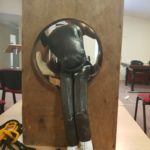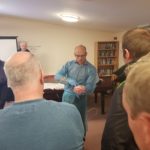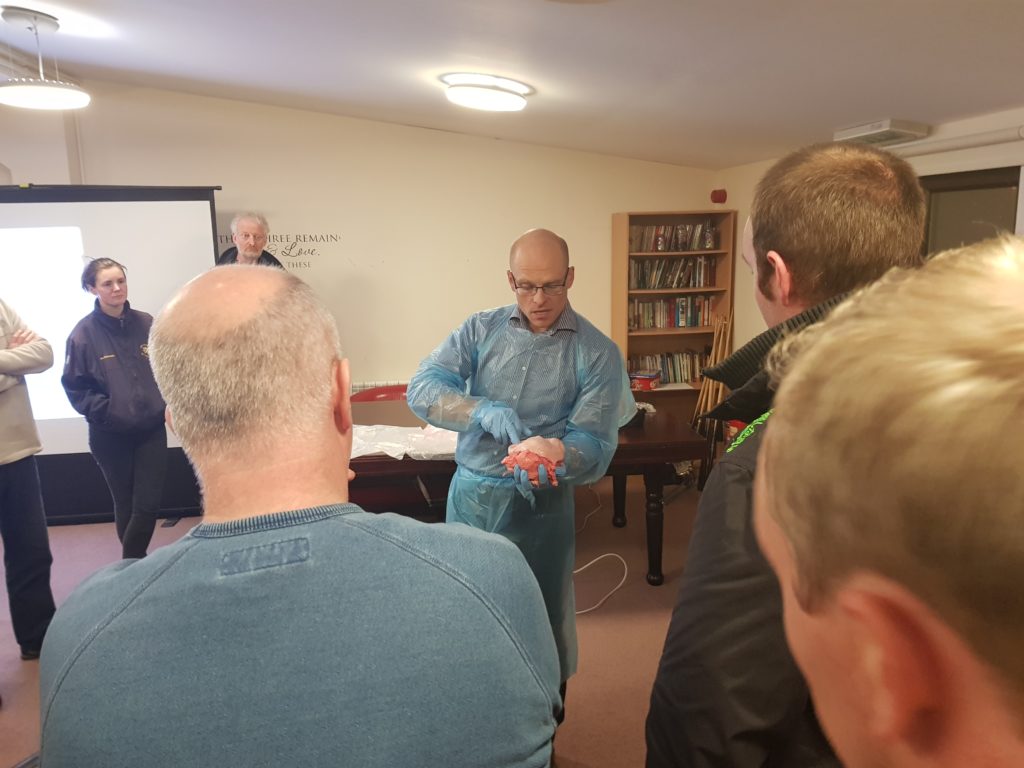Resilience Planning for your Cattle Herd (Balivanich) – Event Summary
2 November 2017Calving Season Approaching
With calving on the horizon crofters in Uist met to discuss a number of topical issues for their cattle herd. SAC vet Franz Brulisauer was the main speaker of the evening giving informative talks on Johnes disease and calving with the view to help minimises losses this calving season. Franz had taken the calving simulator with him from Inverness which generated a good bit of discussion about technique on the evening. Local SAC staff gave a presentation on what to expect in a silage analysis and how to tailor rations according this calving season.
Top tips for assisted calvings
On the topic of calving the hope every year is for every cow to deliver a healthy calf on its own. For those that need a little helping hand however there were a few tips : –
Normal presentation
- Apply traction when the cow is assisting with an abdominal press.
- Pull straight until the head and shoulders are out, and then pull in a slightly downward direction
Twisting the calf

As the maternal pelvis is oval in shape, the widest part is diagonally across. The aim here is to rotate the calf so the widest part of the calf pelvis passes through the widest diameter of the cow’s pelvis. Rotation of the foetus can begin once the shoulders are out of the vulva. Rotation of the calf should occur before the calf pelvis enters the birth canal of the cow/heifer. If you are using a calving jack you will need someone to help. They should wrap hands and arms around neck and shoulders and manually twist the calf. You are looking for a 60 to 90 degree rotation in the pelvis.
Breech presentation
This is risker because the umbilical cord ruptures early, often before the calf’s head is out. A calf in breech position should first be rotated 60-90 degrees by crossing the legs. This should be started before starting to apply traction to take advantage of the widest diameter of the cow’s pelvis. Once the hocks are outside the vulva, rotate the calf back to its normal position The direction of pull to start is slightly up from a horizontal line straight out from the back of the cow. Traction should be slow and controlled until the calf’s tail head and anus begin to emerge from the cow’s vulva. Once this point is reached, delay should be avoided.
Calving jack caution
When applying traction, the force of one person per leg should be sufficient. The pressure exerted by two people pulling is around 400 psi. However on many farms, a calving jack is routinely used. Please remember that a calving jack can exert as much as 2000 psi and so if used incorrectly can cause damage to the cow and calf.
You can download related information to the topics discussed through the links below.
- Calving techniques
- Topics: Livestock
- Beef & Sheep Outlook for 2017 – Cows Pre-Calving
- Topics: Livestock
- Carbon Footprinting in the Beef Herd
- Carbon Footprinting in the Beef Herd: A practical guide
- Livestock nutrition
- Livestock nutrition: A practical guide
- Topics: Climate Change
- Practical Guide: Silage Testing: Interpreting the Results
- This practical guide looks at helping to maximise performance of housed cattle by improving the use of silages.
- Topics: Climate Change
- Silage Analysis & Ration Planning
- Mary McDowell presentation - Benefits of knowing what you're feeding your stock
- Rationing the Suckler Cow For Improved Efficiency
- A brief guide to feed terminology and silage analysis
- QMS Guide to improving suckler herd fertility
- Managing and improving the fertility of your suckler herd is one of the key ways to improve cow margins and hence business profitability. This booklet from QMS is designed to help you assess your herd’s fertility and identify scope for improvement, and provides ideas you can put into practice on your farm.
- Top tips on reviving a new born calf
- Topics: Livestock
Sign up to the FAS newsletter
Receive updates on news, events and publications from Scotland’s Farm Advisory Service

